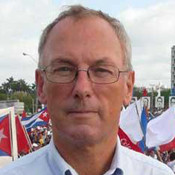The people of Cuba are coming to terms with a country without its symbolic-and-iconic leader.Many in the island nation have never known a life without the presence of Fidel Castro.
Castro came to power in 1959 at the height of the Cold War. He quickly became a formidable force on the world stage.
The United States was determined to prevent Communism from gaining a foothold in the Americas. And in 1961, President Kennedy approved a disastrous ill-fated invasion, called the Bay of Pigs.
CCTV’s Michael Voss met two men who were there that day and joined the fight.

The Bay of Pigs is an isolated inlet on Cuba’s southern coast some 200 kilometers from the capital Havana. Its tranquil palm-lined beaches hide a bloody past.
It was here, in April 1961, that Cuban troops, led by Fidel Castro defeated an invading force of some 1400 Cuban exiles, trained and financed by the U.S. Central Intelligence Agency.
Cuba was expecting an invasion and there were local militias all over the island on the lookout. Domingo Rodriguez still lives beside the beach in the Bay of Pigs and was one of the first on the scene.
“It was still dark when some boats were heading this way with intentions to come ashore at this point. Then we shot at them preventing them from landing.”
But not for long. This initial group of island defenders was soon forced to retreat.
The CIA had predicted that once the invading force landed on the beaches there would be a popular uprising here against Fidel Castro. In the end the exact opposite happened.
The vast majority of Cubans rallied in support of the government. Fidel Castro headed straight to the front line and personally took charge of the counteroffensive. It was a huge morale booster for the troops.
“Oh! When Fidel arrived it was a great thing! Every one of us followed him and again, we never feared anything, we were never afraid. And we chased the mercenaries and we arrested all and every one of them,” Rodriguez said.
Bernardino Alonso, another Bay of Pigs veteran says, “Seeing Fidel arrive was like saying we are done with the mercenaries. That was the crucial moment. Fidel arrived and everybody shouted: the Comandante arrived, here is the Comandante and then, everyone followed him forwards and that was it.”
By the morning of Day three it was over. More than a thousand men surrendered. Later they were sent back to Miami in exchange for $50 million worth of U.S. food and medicines.
In the end Fidel Castro survived nine successive U.S. Presidents and retired due to ill health, while the system he created remains to this day.
 CGTN America
CGTN America

